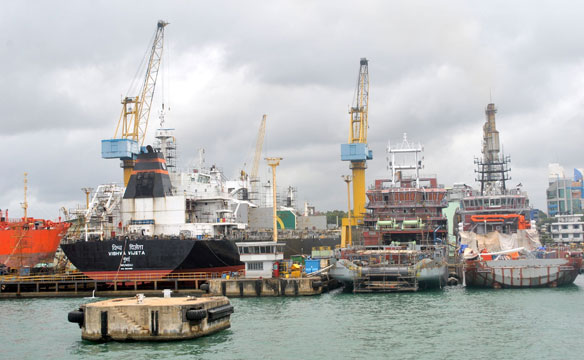SLPA seeks to diversify transshipment business
Looks at joint international marketing plan:
By Chandani Jayatilleke
|

SLPA Chairman
Dhammika Ranatunga |
With a big increase in the number of mega-container carriers calling
at the Colombo Port, the Sri Lanka Ports Authority (SLPA) is keen to
have a joint international marketing effort for the harbour together
with the two private terminal operators, says SLPA Chairman Dammika
Ranatunga in an interview.
It also wants to ensure that the new investor in the East Container
Terminal, for which preliminary bids have been called, will bring in new
business, and the government has decided that the Public Utilities
Commission of Sri Lanka (PUCSL) will be the port regulator.
Excerpts:
Q: What is the level of international interest in Colombo
port's East Container Terminal for which the SLPA has called Expressions
of Interest (EOIs) in the pre-qualification stage to build and operate
the terminal?
A: We are at the EOI stage and the deadline has been extended
to September 22. This was the second extension. Bidders will not be
known until the bids are closed.
However, judging by interest shown by key players in the field, there
are very encouraging signs of stiff competition among them.
The majority, we believe, is from the subcontinent. The government
has given us a directive to consider a strategic partner from the
subcontinent who has more than a 20 percent share. However, it is not
mandatory to qualify at this stage.
Once they appoint a committee to proceed with the process, the
committee will go through the requirements.
Q: As the chairman of the SLPA, what is your view on choosing
an investor?
A: The SLPA should get an investor who can bring new business;
that is crucial for us. We already have three terminals at the port of
which two terminals (CICT and SAGT) are run by the private sector which
own the majority shares. The other terminal is operated by SLPA.
At present the three terminals are competing and my view is that it
is not a healthy situation. I believe we need to do a concerted
marketing plan, putting our strengths together and get more volumes in.
We have had preliminary discussions. I have spoken to the two CEOs.
We should market the Colombo port as 'one port' and sell everyone's
strengths. We have deep draft terminals and a good feeder vessel
network.
There's enough business for everyone to grow. We are already a
competitive and an established transshipment port. We need to let the
world know who we are, together.
We do not want an investor to come in and take a share of the
business we already have.
When you develop a new terminal the tendency in the past was to take
away some of the business the other terminals had.
We want new businesses in the East Terminal. There was a 160% growth
in bigger vessels coming to the Colombo port last year.
Q: What was the overall growth in the first half of this year?
|

The Colombo Port. |
A. In the first six months of this year, the Colombo port is
the only port which showed a double digit growth - a little over 11%
compared with global ports.
It's a good sign, given the fact that the industry is not performing
so well at present.
Q: How can the Colombo Port reduce dependence on a few key
markets such as India to generate container volume growth, especially
since India is expanding its own container ports?
A: We are not depending on India or any other country. But
India does more volumes with us and we need each other for this
business.
That is the reason why we are looking at other markets such as
Bangladesh, Myanmar, the East Coast of Africa, Pakistan and the Gulf.
To encourage transshipment we offer rebates on stevedorage for east
coast of India cargo that includes Bangladesh and Myanmar. We also
provide a lot of value addition such as Multi Country Consolidation,
entrepot and bonded cargo handling.
On the other hand, India has lot of plans to develop ports around the
country.
It has lot of potential to grow and every country prefers direct
shipping for its export-import cargo. Indian ports should develop
because the cargo should get in and out of India. We also have a
strategy to develop our terminals simultaneously.
We also need to look at other businesses within the industry. Our
services need to be improved and we are working on a plan now.
The Colombo port is an international transshipment hub with an
excellent feeder network, with a deep water harbour with two more
terminals to be built within the new South Harbour with 4.8 million
20-foot equivalent container capacity.
Our tariffs are very competitive and I believe it will not be easy to
match our tariffs by any new comer.
We are a 24-hour port which is an advantage. Many other ports do not
have this advantage - as they have to stop business sometimes due to
high tide.
Q: What are the plans for the Colombo North port? Is it for
containers or other business?
A: The North port is currently at a conceptual stage. The SLPA
conducted a study on future development options in 1996 and identified
the area north of Port of Colombo has potential for containers.
Looking at the trends of the container business, while the capacity
created with the completion of the Colombo Port Expansion Project will
fulfill the capacity requirement in the near future. There are strong
prospects for North Port development.
Q. How do you hope to develop the Trincomalee port where
Singapore's Urbana is drawing up an urban master plan?
A: The port of Trincomalee commands a large natural and a wide
body of sheltered water. The SLPA has plans for Trincomalee to give a
considerable contribution through services and investments to improve
the living standards of the Eastern community and give more benefits to
the economy of the country.
The SLPA hopes to develop the port of Trincomalee in accordance with
the government's 'Megapolis' plan and also the national port master plan
developed by the ADB.
Q: What are the development plans for Galle, Hambantota and
Kankesanturai (KKS) ports?
A: Galle has been identified as a leisure port, apart from
being an industrial port. There are plans for building marinas and two
investors have shown interest in it.
The KKS port has the potential to be developed as a regional port to
serve the Northern and North Central provinces.The Indian government has
completed the dredging work and wreck removal. Further the Indian
government has expressed its willingness to give a credit line for the
development of this port.
The Port of KKS has potential in the import of raw materials for the
cement manufacturing industry as well as cement powder imports and
exports of consumables.
Under phase 1 and 2 of the Hambantota Port development project,
massive infrastructure facilities have been developed with the financial
assistance of the Chinese government. In spite of the lack of business
there, we are making every effort to bring in more business to the port
and earn revenue.
Q: When will an independent port regulator be set up to
regulate the different State and private sector port terminals,
especially since more private terminals are planned?
A: We submitted a Cabinet memorandum on March 28, 2016 to the
Cabinet of Ministers and it was referred to the Committee of Economic
Management for recommendations. They decided to let Public Utilities
Commission of Sri Lanka become the overall regulator.
Q: What is the delay in the e-commerce initiative? When will
we see all documentation for import/export and port entry/exit and cargo
tracking go digital as is done in modern ports?
A: There is no delay in deploying our planned ICT initiatives
as our systems in SLPA do already offer many of the trending e-commerce
application features to our clientele.
For example many important areas in the export/import cargo modules
are already using electronic transfers such as e-release with Customs,
Electronic Manifest, electronic services order request facility and EDI
messaging.
But to implement a full-fledged e-commerce application, our systems
need to be linked with all the other stakeholders such as the Customs,
banks, shipping agents, and container operators.
In industrial technology, this is called the Port Community System
where seamless integration with a Single Window concept to share
information between all stakeholders in our business is achieved and
this is what we are targeting. We have already commenced deploying
initial stages of the above initiatives and these features would be
implemented in phases in the future. |

